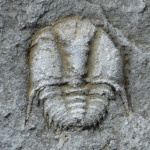 New discoveries in trilobite research: a large sample of developmental stages of trilobite genus Dalmanitina from the Ordovician of the Prague Basin allowed Lukáš Laibl and his colleagues to describe ontogeny of basal members of the suborder Phacopina. Adult phacopines are recognised by their fused facial sutures, which in other trilobites are non-fused and used during the moulting process. This means that rather than molting through the sutural gape mode, characterized by opening of the facial sutures and separation of the librigenae, adult phacopines disarticulated the entire cephalon in so called Salter’s mode of molting. Early developmental stages of Phacopina, however, moulted by sutural gape mode because they retained unfused facial sutures. The fusion of facial sutures occured during the postembryonic development and its developmental timing was intraspecifically fixed in most of the members of the group. However, this was not the case for Dalmanitina as in this genus facial suture fusion occurred variably in ontogeny. This confirms the hypothesis that basal members of major clades have less contrained developmental programs. The material also provides insight into how linked morphologies and behaviors evolved, potentially suggesting the timing of facial suture fusion in Phacopina moved earlier during development and became more intraspecifically fixed over geological time.
New discoveries in trilobite research: a large sample of developmental stages of trilobite genus Dalmanitina from the Ordovician of the Prague Basin allowed Lukáš Laibl and his colleagues to describe ontogeny of basal members of the suborder Phacopina. Adult phacopines are recognised by their fused facial sutures, which in other trilobites are non-fused and used during the moulting process. This means that rather than molting through the sutural gape mode, characterized by opening of the facial sutures and separation of the librigenae, adult phacopines disarticulated the entire cephalon in so called Salter’s mode of molting. Early developmental stages of Phacopina, however, moulted by sutural gape mode because they retained unfused facial sutures. The fusion of facial sutures occured during the postembryonic development and its developmental timing was intraspecifically fixed in most of the members of the group. However, this was not the case for Dalmanitina as in this genus facial suture fusion occurred variably in ontogeny. This confirms the hypothesis that basal members of major clades have less contrained developmental programs. The material also provides insight into how linked morphologies and behaviors evolved, potentially suggesting the timing of facial suture fusion in Phacopina moved earlier during development and became more intraspecifically fixed over geological time.
Drage H.B., Laibl L., Budil P. (2018): Postembryonic development of Dalmanitina, and the evolution of facial suture fusion in Phacopina. Paleobiology 44, 638-659 (DOI)









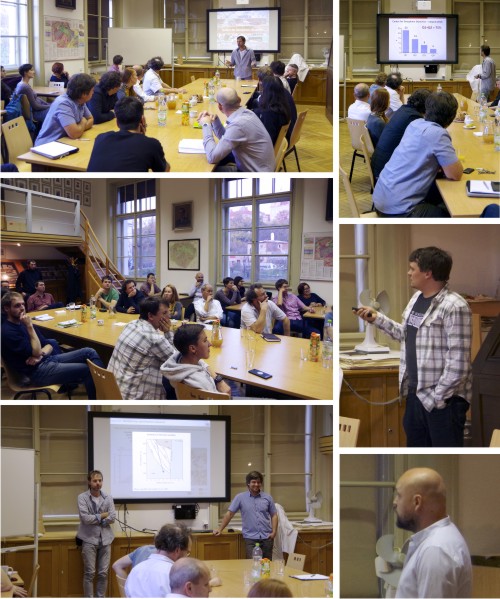
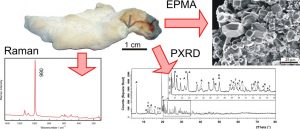 Khademite and rostite are rare orthorhombic minerals Al(SO4)F·5H2O and Al(SO4)OH·5H2O, respectively. Libušín is a type locality of rostite but recent studies have only confirmed the presence of khademite. New electron microprobe analyses of khademite from Libušín revealed a fluorine concentration of 8.12–8.18 wt.%, which is the highest ever found for khademite. Precise discrimination of structurally very similar sulfates is of high importance for geochemical studies and a combination of different analytical methods is preferred to reach this goal.
Khademite and rostite are rare orthorhombic minerals Al(SO4)F·5H2O and Al(SO4)OH·5H2O, respectively. Libušín is a type locality of rostite but recent studies have only confirmed the presence of khademite. New electron microprobe analyses of khademite from Libušín revealed a fluorine concentration of 8.12–8.18 wt.%, which is the highest ever found for khademite. Precise discrimination of structurally very similar sulfates is of high importance for geochemical studies and a combination of different analytical methods is preferred to reach this goal.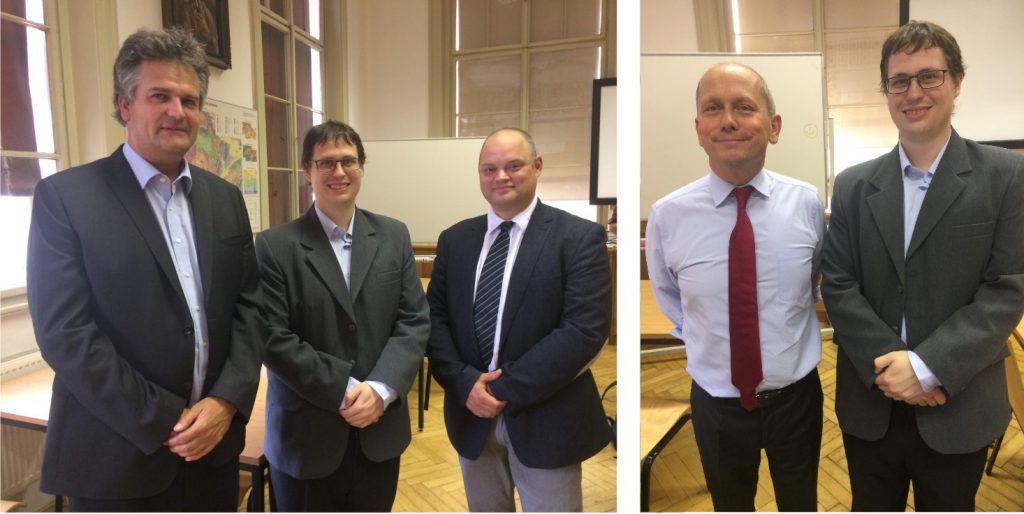 On Friday September 21, 2018, Filip Košek defended his PhD entitled “Application of Raman spectroscopy for detection of sulfates of self-ignited coal heaps“. On the photos you find him together with two reviewers Prof. Ivan Němec from Charles University (left) and Prof. Peter Vandenabeele from Ghent University (Belgium) and his supervisor, Prof. Jan Jehlička. Congratulations!
On Friday September 21, 2018, Filip Košek defended his PhD entitled “Application of Raman spectroscopy for detection of sulfates of self-ignited coal heaps“. On the photos you find him together with two reviewers Prof. Ivan Němec from Charles University (left) and Prof. Peter Vandenabeele from Ghent University (Belgium) and his supervisor, Prof. Jan Jehlička. Congratulations! New U-Pb detrital zircon ages obtained in collaboration with Goethe University (Frankfurt am Main, Germany) and Czech Academy of Sciences from siliciclastic rocks of the Central Bohemian Massif document an intriguing example of how protracted and complex may be a transformation of an active plate margin, controlled by subduction of an oceanic plate, to a passive continental shelf. The northern rim of the supercontinent Gondwana underwent this transition during the late Neoproterozoic to Cambrian times. In their plate-tectonic reconstruction, Hajná et al. assigned a key role to obliquity of the oceanic subduction and impingement of a hot oceanic ridge into the deep sea trench, emhasizing the analogy with modern geotectonic settings.
New U-Pb detrital zircon ages obtained in collaboration with Goethe University (Frankfurt am Main, Germany) and Czech Academy of Sciences from siliciclastic rocks of the Central Bohemian Massif document an intriguing example of how protracted and complex may be a transformation of an active plate margin, controlled by subduction of an oceanic plate, to a passive continental shelf. The northern rim of the supercontinent Gondwana underwent this transition during the late Neoproterozoic to Cambrian times. In their plate-tectonic reconstruction, Hajná et al. assigned a key role to obliquity of the oceanic subduction and impingement of a hot oceanic ridge into the deep sea trench, emhasizing the analogy with modern geotectonic settings.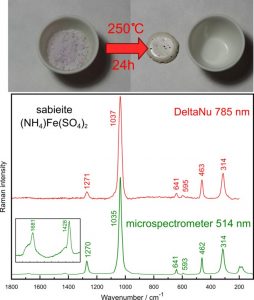 New molecular data on exotic phases mineral occurring in fumarolic systems are reported in this paper. Fumaroles, vents that emit hot gases and vapor, are accompanying phenomena of volcanic activity. Such phenomena are also observed within the framework of self-ignited burning coal seams and coal heap. Rare anhydrous sulfates (millosevichite, mikasaite, efremovite, godovikovite, sabieite, and steklite) are signature minerals of such encrustations. Six synthetic anhydrous sulfates were prepared from the hydrated analogues, and were investigated using both a bench-top Raman microspectrometer and a portable Raman spectrometer. This comparative approach can help further steps for the successful deployments of miniature Raman tools in situ under field conditions. New measurements show that the performance of a light-weight portable Raman spectrometer with near infrared excitation was sufficient for the unambiguous discrimination of the investigated sulfates.
New molecular data on exotic phases mineral occurring in fumarolic systems are reported in this paper. Fumaroles, vents that emit hot gases and vapor, are accompanying phenomena of volcanic activity. Such phenomena are also observed within the framework of self-ignited burning coal seams and coal heap. Rare anhydrous sulfates (millosevichite, mikasaite, efremovite, godovikovite, sabieite, and steklite) are signature minerals of such encrustations. Six synthetic anhydrous sulfates were prepared from the hydrated analogues, and were investigated using both a bench-top Raman microspectrometer and a portable Raman spectrometer. This comparative approach can help further steps for the successful deployments of miniature Raman tools in situ under field conditions. New measurements show that the performance of a light-weight portable Raman spectrometer with near infrared excitation was sufficient for the unambiguous discrimination of the investigated sulfates.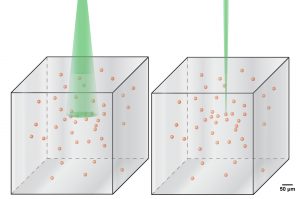 The miniature portable lightweight Raman spectrometer with 532 nm excitation enables unambiguous detection of carotenoids in microscopic inclusions in crystalline laboratory-grown salts – chlorides and sulfates. This is achieved without the use of any microscopic device. The results obtained can serve as a basis for proposing to use portable Raman spectrometers as a tool of first-pass when sampling salt and sulfate crystalline masses for carotenoid analyses in situ at outcrops or drill cores sampling. This report has relevance for search of biomarkers in exobiology context.
The miniature portable lightweight Raman spectrometer with 532 nm excitation enables unambiguous detection of carotenoids in microscopic inclusions in crystalline laboratory-grown salts – chlorides and sulfates. This is achieved without the use of any microscopic device. The results obtained can serve as a basis for proposing to use portable Raman spectrometers as a tool of first-pass when sampling salt and sulfate crystalline masses for carotenoid analyses in situ at outcrops or drill cores sampling. This report has relevance for search of biomarkers in exobiology context.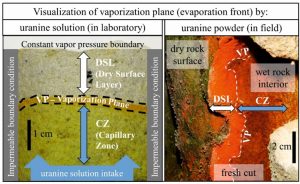 The vaporization plane in porous media separates the region of capillary flow from the dry surface layer, where the water transports in its gas phase. Knowledge of the depth and geometry of the vaporization plane is critical for estimating water flux in the soil-atmosphere interphase, for understanding evaporation processes in general, and for prediction of damaging salt crystallization locations. Use of sodium fluorescein (called also uranine) to visualize the vaporization plane in porous media in both laboratory and field experiments is presented. The property of uranine solution to change its color according to its concentration is used to: i) visualize the vaporization plane by forming a distinctive dark-orange zone where the pore water evaporates, and ii) to distinguish the zone of vapor flow from the zone where capillary flow is present. A complex-shaped vaporization plane in hydrophobic materials is also detectable. Uranine powder, when applied onto a porous material, clearly visualizes the dry surface layer and the capillary zone, divided by the vaporization plane.
The vaporization plane in porous media separates the region of capillary flow from the dry surface layer, where the water transports in its gas phase. Knowledge of the depth and geometry of the vaporization plane is critical for estimating water flux in the soil-atmosphere interphase, for understanding evaporation processes in general, and for prediction of damaging salt crystallization locations. Use of sodium fluorescein (called also uranine) to visualize the vaporization plane in porous media in both laboratory and field experiments is presented. The property of uranine solution to change its color according to its concentration is used to: i) visualize the vaporization plane by forming a distinctive dark-orange zone where the pore water evaporates, and ii) to distinguish the zone of vapor flow from the zone where capillary flow is present. A complex-shaped vaporization plane in hydrophobic materials is also detectable. Uranine powder, when applied onto a porous material, clearly visualizes the dry surface layer and the capillary zone, divided by the vaporization plane. On Tuesday June 12, 2018, Petr Kozlovcev, who is a part-time technician of the Center, defended his PhD entitled “Influence of the mineralogical composition of raw material on phases formed during the burning of hydraulic lime and natural cement”. Congratulations!
On Tuesday June 12, 2018, Petr Kozlovcev, who is a part-time technician of the Center, defended his PhD entitled “Influence of the mineralogical composition of raw material on phases formed during the burning of hydraulic lime and natural cement”. Congratulations!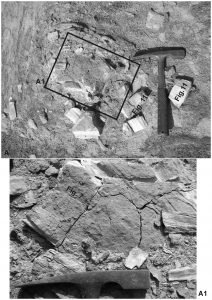 A new species of sessile barnacle Hexaminius venerai, described from the middle Eocene La Meseta Formation of Seymour Island, Antarctic Peninsula, is now the earliest known record of the genus in the Antarctic, its first occurrence from outside Australian waters, and the first record of a fossil cirripede attached to the substrate from the Antarctic. Exceptional preservation of more than 200 specimens revealed intriguing evolutionary aspects, suggesting that this species is a survivor of an early phase in balanid radiation, prior to the development of strong radially-interlocked parietes.
A new species of sessile barnacle Hexaminius venerai, described from the middle Eocene La Meseta Formation of Seymour Island, Antarctic Peninsula, is now the earliest known record of the genus in the Antarctic, its first occurrence from outside Australian waters, and the first record of a fossil cirripede attached to the substrate from the Antarctic. Exceptional preservation of more than 200 specimens revealed intriguing evolutionary aspects, suggesting that this species is a survivor of an early phase in balanid radiation, prior to the development of strong radially-interlocked parietes.